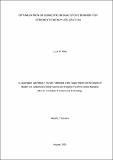| dc.description.abstract | The inefficient indoor burning of fuel wood on traditional cook stoves generates pollutants,
primarily carbon monoxide and many other human health-damaging emissions. It is from this
risk that it is necessary to have an immediate shift to alternative cleaner fuel sources. Biogas,
which is among the biofuels from biomass, is one of the resources that play a considerable
part in a more diverse and sustainable global energy mix. For domestic purposes in rural
areas of Tanzania, biogas provides a better option that can supplement the use of fossil fuels
such as wood, charcoal, and kerosene, which is nonrenewable. However, the low efficiency
experienced in the locally made biogas burners hinders the large-scale use of biogas amongst
the population in the country. With the locally made burners, the users of biogas for the
domestic application face problems including heat loss and high gas consumption which
affects the whole cooking process. It is against this backdrop that the current study objectives
incline on designing and improving the efficiency of the locally manufactured burners to
achieve the uniform flow of fuel in the mixing chamber, which will result to the consistent
heat distribution around the cooking pot. The optimization of the burner was done by using
computational fluid dynamics (CFD) through varying the number of flame portholes, air
holes as well as the size of the jet before fabrication. The increased efficiency of the burner
has also contributed by the addition of the fuel distributor. The results showed that the
optimum hole diameter of the jet was 2.5 mm and that of the manifold was 100 mm. The
currently developed biogas burner was tested and compared with the other two locally made
burners. The water boiling test (WBT) on these three burners showed that the developed
burner has a thermal efficiency of 67.01% against 54.61% and 58.82% of Centre for
Agricultural Mechanization and Rural Technology (CARMATEC) and Simgas respectively.
Additionally, the fuel consumption of the developed burner was 736 g/L as compared to 920
g/L for CARMARTEC and 833 g/L for that of Simgas. The developed burner and its
corresponding cook stove are both environmentally friendly and economical for household
utilization in Tanzania and other developing countries. | en_US |

